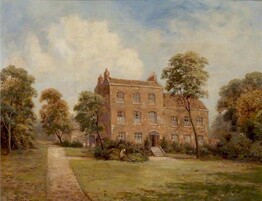In the late 18th and early 19th centuries the spread of villas along some of the lanes branching off High Road was more noticeable than the growth of separate hamlets. The most uniform building, made possible by the break-up of the manorial estate in 1789, took place along the new road called Bruce Grove; superior, semi-detached houses, soon associated with rich Quaker families, lined part of its south-western side by 1800.
The residential nature of most new building gave late-18th-century Tottenham the appearance of an extended, semi-rural suburb rather than a town. Private schools continued to benefit from the relatively healthy air; among them were establishments opened in 1827 at Bruce Castle and in the following year at Grove House, both of which became nationally known.
Tottenham was a very quiet and secluded town, where fortunes could be made by enterprising traders or craftsmen who secured the patronage of the local gentry.
A doubling of the population between 1811 and 1851 was reflected in many new schools and chapels and in the first modern Anglican church, built at Tottenham Green in 1830.
The opening of a railway station in 1840 and of a church at Wood Green in 1844 presaged the establishment of a local board in 1848 and a transformation of the old parish, when the social standing of much housing along High Road would be lowered and the contrast between concentrated development there and open country to the west would be ended. In 1840, however, it was still possible for William Robinson to claim that the pattern of settlement did not differ greatly from that of 1619. All but a few of the inhabitants lived in or near High Road.
Source British History Online - Tottenham: Growth before 1850
The residential nature of most new building gave late-18th-century Tottenham the appearance of an extended, semi-rural suburb rather than a town. Private schools continued to benefit from the relatively healthy air; among them were establishments opened in 1827 at Bruce Castle and in the following year at Grove House, both of which became nationally known.
Tottenham was a very quiet and secluded town, where fortunes could be made by enterprising traders or craftsmen who secured the patronage of the local gentry.
A doubling of the population between 1811 and 1851 was reflected in many new schools and chapels and in the first modern Anglican church, built at Tottenham Green in 1830.
The opening of a railway station in 1840 and of a church at Wood Green in 1844 presaged the establishment of a local board in 1848 and a transformation of the old parish, when the social standing of much housing along High Road would be lowered and the contrast between concentrated development there and open country to the west would be ended. In 1840, however, it was still possible for William Robinson to claim that the pattern of settlement did not differ greatly from that of 1619. All but a few of the inhabitants lived in or near High Road.
Source British History Online - Tottenham: Growth before 1850
Luke Howard's homes in Tottenham
|
|






